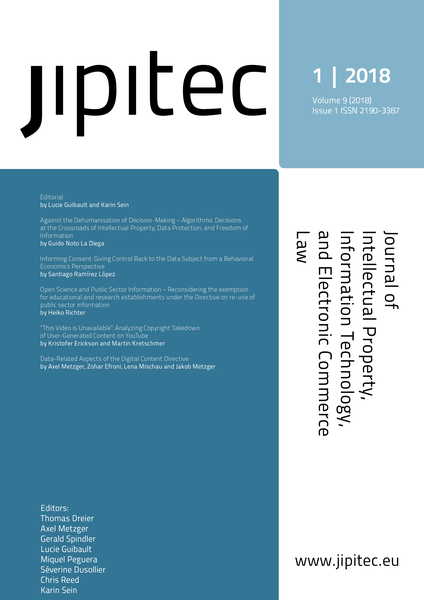“This Video is Unavailable”: Analyzing Copyright Takedown of User-Generated Content on YouTube
Keywords:
Copyright, YouTube, fair use, music industry, notice-and-takedown, parodyAbstract
What factors lead a copyright owner to request removal of potentially infringing user-generated content? So-called “notice-and-takedown” measures are provided in the United States under Section 512 of the U.S. Copyright Act (as amended by the Digital Millennium Copyright Act 1998) and enabled in the European Union under the Directive on Electronic Commerce (2000/31/EC). While the combination of limiting liability (“safe harbor”) and notice-and-takedown procedures was originally conceived as a means of balancing innovation with the interests of rightholders, there has been limited empirical study regarding their effects. This research investigates, for the first time, the factors that motivate takedown of user-generated content by copyright owners. We study takedowns within an original dataset of 1,839 YouTube music video parodies observed between January 2012 and December 2016. We find an overall rate of takedowns within the sample of 32.9% across the 4-year period. We use a Cox proportional hazards model to investigate propositions from rightholder groups about the factors that motivate takedowns: these include concerns about commercial substitution; artistic/moral concerns; cultural differences between firms; and YouTube uploader practices. The main finding is that policy concerns frequently raised by rightholders are not associated with statistically significant patterns of action. For example, the potential for reputational harm from parodic use does not appear to predict takedown behavior. Nor does commercial popularity of the original music track trigger a systematic response from rightholders. Instead, music genre and production values emerge as significant factors. We suggest that evolving policy on intermediary liability - for example with respect to imposing filtering systems (automatically ensuring “stay-down” of potentially infringing content) - should be carefully evaluated against evidence of actual behavior, which this study shows may differ materially from stated policy positions.Published
2018-05-23
Issue
Section
Artikel

